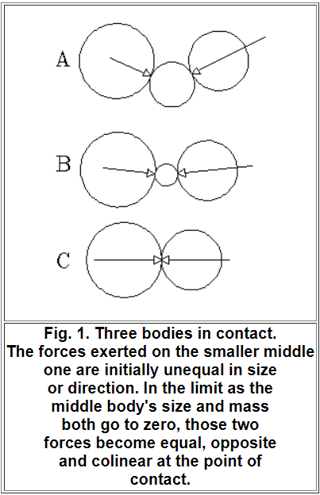You're right to be suspicious of this proof. It's wrong.
The first error is succinctly stated in the fourth paragraph:
[for] a body of mass zero, [...] Newton's second law tells us that $F_{\rm net} = 0a$, so $F_{\rm net} = 0$.
If "bodies" are things that Newton's laws describe then there are no "bodies of mass zero". You can't push a photon.
It's perfectly valid, on the other hand to analyze Newton's second law in terms of limits, as several answers here have done, but you gotta clarify your assumptions. Which quantities are held fixed as you decrease the mass? Which quantities change? There certainly are cases where the net force acting on an object does not vanish as its mass goes to zero: like a rocket ejecting mass, or a sequence of less-and-less massive charged particles in an electric field (e.g. the tau, muon, and electron).
Another error is more subtle. While it's true that in the limit of a massless central body analyzed in Fig. 1, the two forces acting on the outside bodies become equal and opposite, this is a special case. Consider a related case where the central body first collides with the left body, then the right: the two forces acting on the outside bodies become completely unrelated. Or consider a related case where the three bodies are linked like train carts, but an external force is applied to the central body: the two forces acting on the outside bodies do not become equal and opposite as the central mass decreases.
Perhaps the most interesting discovery here, is that the article you linked is not sincere. It's a parody of scientific quackery. The pseudonymous author is "Ken Amis", the true author's surname written backwards. I'm not sure of Simanek's purpose, but this and other parody articles listed on their website may have been used to train students to pay attention.
If you're depressed to have gotten snagged, don't be! You smelled something was off, and inquired deeper. That's a good sign. And Newton's laws are famously subtle. Nobel laureate Frank Wilczeck struggled with them for good reason.


